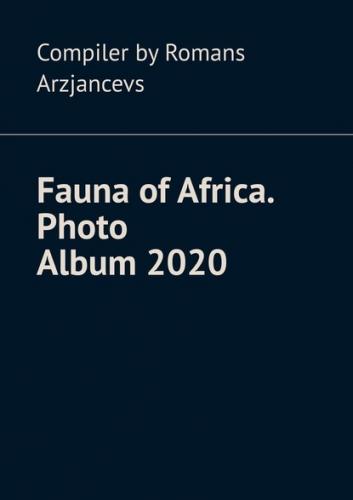Compiler Romans Arzjancevs
ISBN 978-5-0051-4860-5
Created with Ridero smart publishing system
Compiler by ROMANS ARZJANCEVS
FAUNA OF AFRICA
PHOTO ALBUM
2020
USED SCIENTIFIC SOURCES:
1.https://en.wikipedia.org/wiki/Fauna_of_Africa
2.https://www.nationalgeographic.com/animals/mammals
3.https://onekindplanet.org/animal
4.https://drewsproule.com/blog/
5.http://animalia.bio/
6.https://www.safaribookings.com/blog
7. https://www.ducksters.com/animals
8.https://storyteller.travel/
9.https://africafreak.com/
10.https://www.livescience.com/
11.https://www.theanimalfacts.com/mammals
12.https://travelafricamag.com/
13. https://seaworld.org/animals/facts/mammals
ALGERIA
SERVAL
– The Serval diet consists of rodents, birds, frogs, insects, reptiles.
– The Serval tail length is about 20 – 38 cm long.
– The Serval live about 19 years.
ARABIAN RED FOX
– The diet consists of rodents, birds, fish, carrion.
– The small foxes open there eyes on the 10» th day after birth.
– These species of animal mostly active at night.
BARBARY MACAQUE
– The diet consists of plants and insects.
– Males live about 25 years, while females live up to 30 years.
– The main predators of these species are leopards, eagles and domestic dogs.
DROMEDARY / CAMEL
– The Dromedary has 22 milk teeth, which are also replaced by 34 permanent teeth.
– The heart weighs is around 5 kg.
– The pulse rate is 50 beats per minute.
EGYPT
NILE CROCODILE
– This kind of crocodile are ambush predators, that can wait hours, days, and even weeks for the suitable moment to attack.
– The diet of young crocodiles consists of insects and invertebrates.
– The mouths of the Nile crocodile are filled with 64 to 68 cone-shaped teeth.
GAZELLE
– Some are able to run at bursts as high as 100 km/hour or run a sustained speed about 50 km / hour.
– Their natural predators include humans, cheetahs, leopards, Arabian wolves and lions.
– The weight of the Dorcas Gazelle is about 15 – 20 kg.
HIPPOPOTAMUS
– Unlike most other semiaquatic animals, hippos have very little hair. The skin is about 6 cm.
– A Hippos lifespan is typically 40 – 50 years.
– In Niger, in 2014 a boat was capsized by a hippo and 13 people were killed.
HYAENA
– The Striped Hyaena typically only emerges in complete darkness, and is quick to return to it’s lair before sunrise.
– In the wild, the Striped Hyaenas can live for 12 years, while in captivity they have been known to reach 23.
– The Striped Hyaena is sometimes implicated in the killing of livestock, particularly goats, sheep, dogs and poultry.
WESTERN SAHARA
AFRICAN GOLDEN WOLF
– In West Africa, the African golden wolf mostly confines itself to small prey, such as hares, rats, ground squirrels and cane rats.
– In the wild, life expectancy ranges from 6 to 8 years. In other settings, it can live for up to 10 to 18 years.
– Maximum Running Speed is about 64 km/h (40 m/h).
FENNEC FOX
– It mainly eats insects, small mammals, and birds.
– The fennec has a life span of up to 14 years in captivity and about 10 years in the wild.
– The fennec fox is so well-adapted to desert life that it can live without freestanding water.
CHEETAH
– It is the fastest land animal, capable of running at 80 to 128 km/h.
– The
